23 February, 2002
CARPENTRY MATH
Jeff Gustafson is the Palmer Station carpenter. Jeff is from
Warren, Minnesota, which is near the corner where Minnesota, North Dakota,
and Manitoba meet.
Jeff says, " If you have a hard time with math, you'll have a hard time with
carpentry of any sort, from construction to rebuilding things." He says
that all materials are designated by numbers, and math is sort of like an
unwritten plan. All materials are made to certain sizes. They are made to
go together in certain ways and dimensions. Without a uniform numbering
system, he says, it just wouldn't work.
For measurement in the United States, the standard is that the measurements
are divisible by twelve or a fraction of twelve. So, some material might
come in 12" , or 2 inches by 4 inches.
Jeff's work here has mostly been repair and maintenance. He uses scrap wood
as much as possible. Jeff has also built things for the scientists. He has
made containers to hold the sample bottles when the scientists are using
bottles out in the Zodiacs. He has made stands to hold the bamboo stakes.
These stakes mark the transects (lines of travel) on all islands where
penguin studies are continuing. Jeff has also built containers for
machinery that is being sent back to the U.S. He is a busy person!
Jeff says that people are often worried about safety when around saws and
other machinery. Jeff says, "You're your own worst enemy. The machinery
doesn't make a mistake. It's not the saw's fault if an injury occurs!"
This is another example of how mindful people are about safety here at
Palmer Station.
Jeff gave me several math problems. They will appear below as captions for
the images.
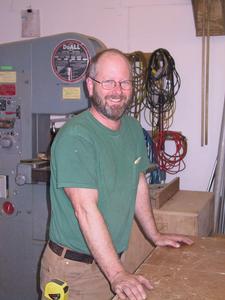
Jeff Gustafson in the carpentry shop.

Did you do the math a different way? How does your answer compare to this? Jeff measured just to see how wide each equal piece will be.
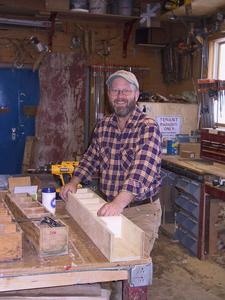
Jeff with the box holder he is making for a scientific group.

Jeff used the marks he made on the diagonal to make cutting lines perpendicular to the edge closest to him in this image.
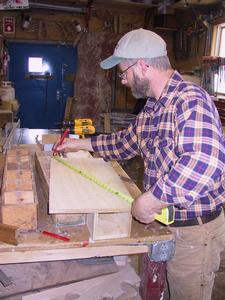
Here's another math problem: Jeff has a length of board. It is 27 inches long. He wants to make 6 shelves. He doesn't care how wide the shelves will be. He just doesn't want any pieces of wood left over. How wide should each shelf be? One way Jeff does this is by using a diagonal to do his math. He stretched the measure from one corner in the direction of the opposite corner. He moved the diagonal until he had a measure of 30 inches. He chose a length of 30, because it is easily divisble by 6. Then, he made a mark every five inches on that diagonal.
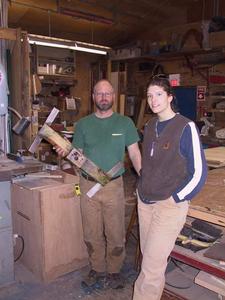
Heidi Geisz of the seabird group has stopped by the carpentry shop to ask Jeff to make these stands for bamboo stakes. The seabird group uses the stakes to mark out transect lines on the islands where they conduct penguin studies. Heidi said that the stands need to be repaired or replaced because elephant seals sometimes destroy them!
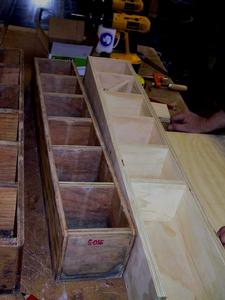
1. A scientist needs a wooden box to hold six bottles. Each square opening = for the bottle must be 4 =BE inches square. Jeff separates each square opening with a piece of wood that is approximately 5/8 inch wide. How long will this bottle container have to be?
Contact the TEA in the field at
.
If you cannot connect through your browser, copy the
TEA's e-mail address in the "To:" line of
your favorite e-mail package.
|
